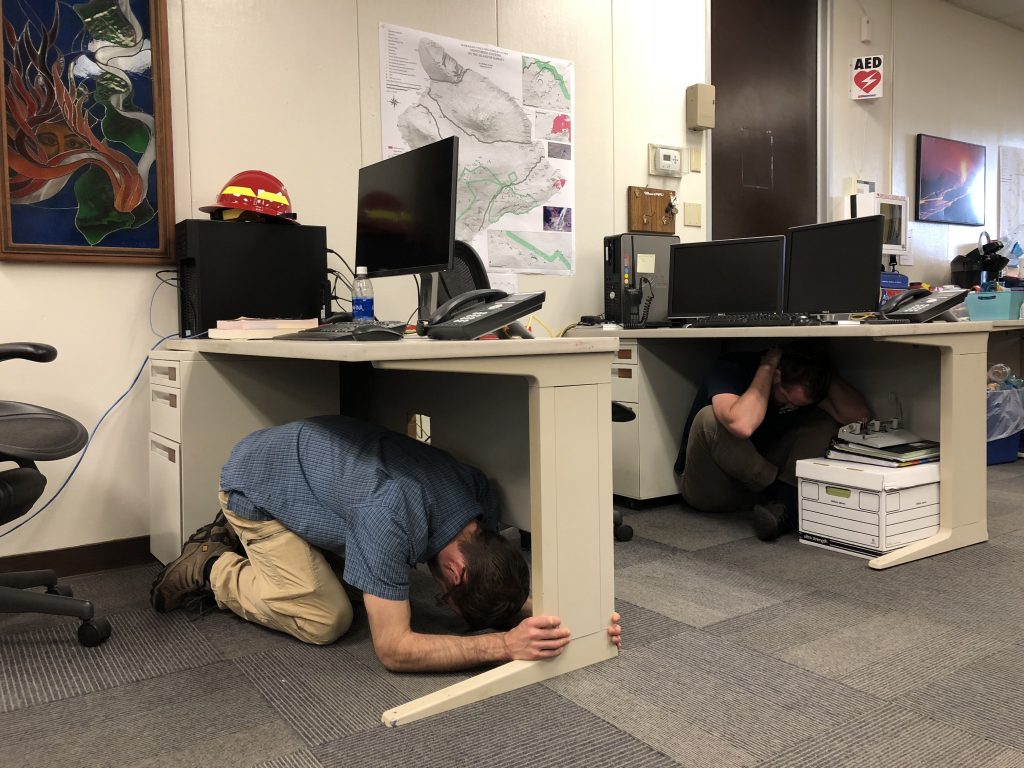HVO UPDATE: Deformation Signals Consistent With Refilling
The Hawaiian Volcano Observatory reports that Kīlauea Volcano is not erupting as of Tuesday, Oct. 23, 2018. Rates of seismicity, deformation, and gas release have not changed significantly over the past week. Deformation signals are consistent with refilling of the middle East Rift Zone.
Observations: HVO monitoring during the past week shows low rates of seismicity at the summit and East Rift Zone (ERZ). Earthquakes continue to occur primarily at Kīlauea’s summit area and south flank (magnitude-3.8 was the largest) with continued small aftershocks of the magnitude-6.9 quake on May 4, 2018. Seismicity remains low in the lower ERZ.

On Oct. 18, at 10:18 a.m., scientists at the Hawaiian Volcano Observatory practiced “Drop, Cover, Hold on!”—the best actions to take during an earthquake to prevent injuries—during the Great Hawai‘i ShakeOut. Since 1868, more than 30 magnitude-6.0 or greater earthquakes have rattled the Hawaiian Islands—most recently on May 4, 2018 (M6.9)—so it’s important for Hawaii residents to know (and practice) what to do when the ground shakes. The Great Hawai‘i ShakeOut is an annual earthquake awareness and preparedness event held on the third Thursday of October. PC: HVO
In the ERZ, tiltmeters near Puʻu ʻŌʻō and farther east continue to record an inflationary trend, consistent with refilling of the middle East Rift Zone. At the summit, tiltmeters have recorded a slight inflationary trend. At the summit, UWE tiltmeter started a deflationary trend around Oct. 18, 2018 at 6:30 p.m. and seems to have completed a DI cycle over three to four days since.
Sulfur dioxide gas emissions at the summit, Puʻu ʻŌʻō, and the ERZ remain drastically reduced. The most recent SO2 emission measurements, from late September, show a combined rate of less than 300 tonnes/day. Bad weather has prevented new SO2 emission rate measurements; however, downwind SO2 concentrations suggest that no major changes have occurred over the last week.
Hazards are still present in the lower East Rift Zone (LERZ) eruption area and at the Kīlauea summit. Residents and visitors near recently active fissures and lava flows should stay informed, heed Hawai‘i County Civil Defense and National Park warnings, and be prepared, if necessary, to self-evacuate in the unlikely event of renewed activity. Please note that Hawai‘i County maintains a closure of the entire flow field and the vents and prohibits access to the area unless authorized through Civil Defense.
The Hawaiian Volcano Observatory (HVO) continues to closely monitor Kīlauea’s seismicity, deformation, and gas emissions for any sign of reactivation, and maintains visual surveillance of the summit and the East Rift Zone. HVO will continue to issue a weekly update every Tuesday and additional messages as warranted by changing activity.















